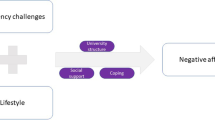Abstract
We explored the ways that religion and spirituality (R/S) work as a cultural asset in the lives of medical students and how students anticipate using this asset as physicians. A group of sixteen religiously diverse medical students were interviewed, and data were analyzed using grounded theory. The results indicate that regardless of faith, students repurposed their R/S to help them cope with the stress of medical school, make clinical decisions, resolve inexplicable events, and practice patient-centered care. Medical educators should leverage this asset to help students understand how to practice in ways that are consistent with patient-centered care.
Similar content being viewed by others
References
Aiyer, A., Ruiz, G., Steinman, A., & Ho, G. (1999). Influence of physician attitudes on willingness to perform abortion. Obstetrics & Gynocology, 93(4), 576–580.
Au, K., & Kawakami, A. (1994). Cultural congruence in instruction. In E. Hollins, J. King, & W. Hayman (Eds.), Teaching diverse populations: Formulating a knowledge base (pp. 5–24). Albany, NY: State University of New York Press.
Balboni, M., Bandini, J., Mitchell, C., Epstein-Peterson, Z., Amobi, A., Cahill, J., et al. (2015). Religion, spirituality, and the hidden curriculum: Medical student and faculty relfections. Journal of Pain Symptom Management, 50(4), 507–515.
Barnard, D., Dayringer, R., & Cassel, C. (1995). Toward a person-centered medicine: Religious studies in the medical curriculum. Academic Medicine, 70(9), 806–813.
Benson, P., Leffert, N., Scales, P., & Blyth, D. (1998). Beyond the “village” rhetoric: Creating healthy communities for children and adolescents. Applied Developmental Science, 2(3), 138–159.
Borrero, N. (2009). English language learners making connections between home and school. Educational Leadership, 66(7), 60–61.
Bronfenbrenner, U. (1979). The ecology of human development. Cambridge, MA: Harvard University Press.
Bull, M. (1990). Secularization and medicalization. British Journal of Sociology, 41(2), 245–261.
Christakis, N., & Asch, D. (1995). Physician characteristics associated with decisions to withdraw life support. American Journal of Public Health, 85(3), 367–372.
Cooper, C. R. (2011). Bridging multiple worlds: Cultures, identities, and pathways to college. Oxford: Oxford University Press.
Curlin, F., Lawrence, R., Chin, M., & Lantos, J. (2007). Religion, conscience, and controversial clinical practices. New England Journal of Medicine, 356(6), 593–600.
Curlin, F., Roach, C., Gorawara-Bhat, R., Lantos, J., & Chin, M. (2005). How are religion and spirituality related to health? A study of physicians’ perspectives. Southern Medical Journal, 98(8), 761–766.
Delgado, M. (2007). Social work with Latinos: A cultural assets paradigm. New York: Oxford University Press Inc.
Festinger, L. (1962). A theory of cognitive dissonance (Vol. 2). Stanford, CA: Standford University Press.
Glaser, B. G., & Strauss, A. L. (2009). The discovery of grounded theory: Strategies for qualitative research. New Brunswick: Transaction Publishers.
Guck, T., & Kavan, M. (2006). Medical student beliefs: Spirituality’s relationship to health and place in medical school curriculum. Medical Teacher, 28(2), 702–707.
Ivtzan, I., Chan, C., Gardner, H., & Prashar, K. (2013). Linking religion and spirituality with psychological well-being: Examining self-actualisation, meaning in life, and personal growth initiative. Journal of Religion and Health, 52(3), 915–929.
Lawrence, R., & Curlin, F. (2009). Autonomy, religion and clinical decisions: Findings from a national physician survey. Journal of Medical Ethics, 35, 214–218.
Lucchetti, G., Lucchetti, A., & Puchalski, C. (2012). Spirituality in medical education: Global reality? Journal of Religion and Health, 51, 3–19.
Mezirow, J. (1997). Transformative learning: Theory to practice. New Directions for Adult and Continuing Education, 74, 5–12.
Moll, L., Amanti, C., Neff, D., & Gonzalez, N. (1992). Funds of knowledge for teaching: Using a qualitative approach to connect homes to classrooms. Theory into Practice, 31(2), 132–141.
Mollat, M. (1986). The poor in the Middle Ages: An essay in social history. New Haven, CT: Yale University Press.
Nerlove, S., & Snipper, A. (1981). Cognitive consequences of cultural opportunity. In R. H. Munroe, R. L. Munroe, & B. B. Whiting (Eds.), Handbook of crosscultural human development (pp. 423–474). New York: Garland Press.
Nieto, S. (2002). Language, culture, and teaching: Critical perspectives for a new century. Mahwah, NJ: Lawrence Erlbaum Associates Inc.
Numbers, R., & Sawyer, R. (1982). Medicine and Christianity in the modern world. In M. Martin & K. Vauz (Eds.), Health medicine and the faith traditions: An inquiry into religion and medicine (pp. 133–160). Philadelphia: Fortress Press.
Porter, R. (1993). Religion and medicine. In W. F. Bynum & R. Porter (Eds.), Companion encyclopedia of the history of medicine. New York: Routledge.
Saleem, S., & Saleem, T. (2017). Role of religiosity in psychological well-being among medical and non-medical students. Journal of Religion and Health, 56(4), 1180–1190.
Schonfeld, T., Schmid, K., & Boucher-Payne, D. (2016). Incorporating spirituality into health sciences education. Journal of Religion and Health, 55, 85–96.
Strauss, A. L., & Corbin, J. (1998). Basics of qualitative research: Techniques and procedures for developing grounded theory. Thousand Oaks, CA: Sage Publications Inc.
Tharp, R., & Gallimore, R. (1998). Rousing minds to life: Teaching, learning, and schooling in social context. New York: Cambridge University Press.
VanderWeele, T., Balboni, T., & Koh, H. (2017). Health and spirituality. JAMA, 318(6), 519–520.
Vicini, A., Shaughnessy, A., & Duggan, A. (2017). On the inner life of physicians: Analysis of family medicine residents’ written reflections. Journal of Religion and Health, 56(4), 1191–1200.
Williams, C., Wilson, C., & Olsen, C. (2005). Dying, death, and medical education: Student voices. Journal of Palliative Medicine, 8(2), 372–381.
Wyatt, T., Bowen, J., Mann, K., Regehr, G., & Cianciolo, A. (2016). Coming in from the cold: Pysician professional development as deepening participation in the healthcare community. Teaching and Learning in Medicine: An International Journal, 28(4), 1–4.
Author information
Authors and Affiliations
Corresponding author
Rights and permissions
About this article
Cite this article
Ray, C., Wyatt, T.R. Religion and Spirituality as a Cultural Asset in Medical Students. J Relig Health 57, 1062–1073 (2018). https://doi.org/10.1007/s10943-017-0553-3
Published:
Issue Date:
DOI: https://doi.org/10.1007/s10943-017-0553-3




